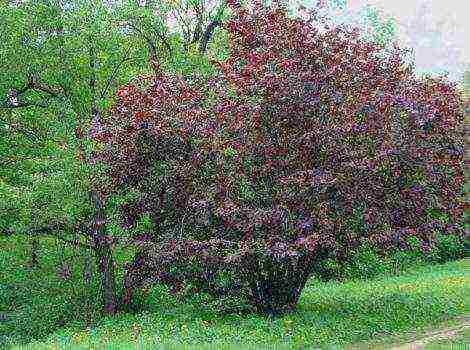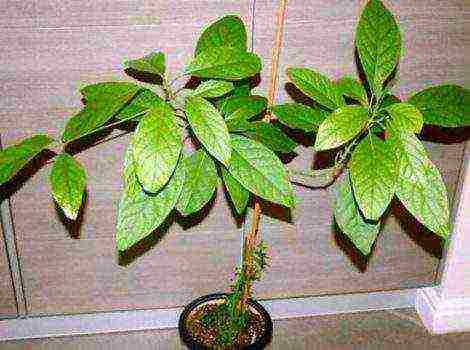Content
Mushroom pickers have long noticed that in the natural environment, fungi reproduce well not only by spores, but also by myceliums - fragments of fungal tissue.
This property was adopted and began to grow the mycelium of champignons and other mushrooms in laboratories and even apartments. We will learn how to grow "seeds" for planting ourselves, so that later we can grow home crops of such a useful and tasty mushroom.
Growing mushroom mycelium at home
Planting materials for obtaining mushroom harvests are necessary for both farmers and those who have decided to start cultivating champignons for their own consumption. You can, of course, plant the mushroom mycelium from a purchased mycelium, saving energy (but not money), but this does not guarantee the quality of the product. This is why some mushroom growers prefer to obtain compost or grain mycelium on their own.
To obtain material for planting, spores are sown or it is excreted from the fruiting body of the mushrooms, for which a special nutrient medium is used.
Culture medium options
Self-cultivation of champignon is carried out in the following substrates:
In wort-agar
- Mix a liter of beer wort with agar-agar (20 grams) and boil until it dissolves.
- Pour the composition into test tubes, occupying no more than a third, plug with cotton wool and keep it in an autoclave for 30 minutes at 101 degrees and 1.5 atmospheres.
- We arrange them in a very inclined form, leaving a distance of 3.5 cm to the corks, and wait until the wort hardens.
Usually mushroom pickers use this particular composition to make champignon mycelium with their own hands.
In oat agar
- Mix water (liter), oat flour (35 g) and agar-agar (20 g), boil for an hour, stirring regularly, and pass through a Gause filter.
- Pour into test tubes and wait for solidification.

In carrot agar
- Grind the carrots, mix with water in a ratio of 2: 5, cook for 30 minutes and filter - you get a carrot extract.
- We mix this extract (0.4 l), water (0.6 l) and agar-agar (15 grams).
- We pour into test tubes according to the first method and leave to solidify.
When the nutrient medium for producing compost with mushroom mycelium hardens, add particles of fruit bodies or spores to the test tubes (observe sterility!).
For this process, an inoculation loop is required, which, like the mushroom mycelium, can be easily created with your own hands by calcining a knitting needle or steel wire over a fire.
Hydrogen peroxide, which needs to be treated with mushroom tissues, and opening the test tubes over a flame will help to create sterile conditions. We must burn the corks with fire.
How to grow mushroom mycelium
Until the test tubes overgrow, we keep them in a dark room (thermostats) at 24 degrees of heat: after a couple of weeks, the myceliums will completely master the culture media and will be ready for planting.
Growing mushroom mycelium at home allows you to get grain and compost planting materials.
Types of mushroom mycelium
Compost mycelium
You can get compost with mushroom mycelium using the following technology:
- Place the mushroom substrate, made as described above, in 3 liter jars, filling them to 23.
- We seal it and make a three-centimeter hole in the middle.
- We roll up the jar with an ordinary steel lid, making the same hole in it, and plug it with a cotton and gauze swab.
- We heat the compost to 24 degrees and add the mushroom material there.
We immediately plug the hole in the lids of the jars to protect the mycelium from infection.

Grain mycelium
It prepares like this:
- We put 10 kilos of grain into the tank and pour water (15 liters).
- We put on low heat and cook after boiling for 30-60 minutes: it depends on the hardness of the product.
At the exit, we get soft, but not boiled grains.
- We drain the water and dry the boiled grain, sprinkling it with a three centimeter layer.
- We pour the dried substrate into liter jars with holes in the lids (we also make holes in the grain mass), plug it with gauze and cotton swabs and put it in an autoclave with a pressure of 1.5 atmospheres for an hour and a half.
- Cool the contents of the jars and add mushroom material to the holes made in the grain mass.
We keep the jars in thermostats at 24 ° C until the mycelium completely assimilates the nutrient medium.
So, you have learned how to prepare the mushroom mycelium with your own hands. Finally, we advise you to store grain mycelium in cellophane bags for no longer than 6 months, keeping the temperature no higher than 4 ° С, and the compost one - in a cold place at 0 ° С for no more than a year.
You can store planting material in a warm room with a temperature of up to 18 ° C for 20 days, no longer, and then planting the mushroom mycelium will bear fruit.
Growing mushrooms in a private household, in dachas and even in apartments is becoming fashionable today. Firstly, in the store, mushroom products are not sold at a low price. Secondly, the homemade mushroom, grown without the use of unknown chemicals, is environmentally friendly and safe for consumption. Thirdly, mushroom growing can be made a profitable business, or at least a good source of additional income. Fourthly, it is a very interesting and exciting hobby. Take a substrate, put mycelium in it, create conditions. And it starts to grow like mushrooms.
Growing champignons at home for beginners
Before you start growing mushrooms
You need to think well and weigh your desire and capabilities on two scales. If they are at about the same level, it is worth the risk. Information for beginners: growing mushrooms at home is a more laborious process than growing oyster mushrooms. But less long-term and more effective than growing porcini mushrooms.
It will take certain costs for the purchase of materials, arrangement of the premises, as well as patience and certain skills. Provided that you already have a suitable room and you only need to create favorable conditions in it.
Premises
It should be moderately cool, such as a cellar or basement. If neither one nor the other is not present, it is difficult to advise anything. Perhaps a garage or greenhouse will do (during the cold season). In spring and early summer, before the onset of extreme heat, mushrooms can be grown without a room at all. The main thing is that the air temperature is not higher than + 20 ° С. Indoors, in the case of year-round cultivation, the temperature should be constantly maintained in the range of + 12 ° C ... 18 ° C, and the humidity should be in the range of 65-85%.
Premises for growing mushrooms
Substrate
The most important item on the list of prerequisites for the successful cultivation of mushrooms is the substrate (or, as it is also called for its composition, compost). The following composition is generally recognized as a fruitful compost option.
- Horse or cow dung (or pork or bird droppings, which can be taken, but not desirable).
- Straw.
- Urea.
- Superphosphate.
- Gypsum.
- A piece of chalk.
- Alabaster flour.
Substrate for growing mushrooms
Table. The proportions of the components for making compost from mullein or horse manure.
Table. The proportions of the components for the composting of poultry manure.
By the way! To cover a one square meter area with mushroom compost, you need compost made from 40 kg of straw base (the rest of the components, according to the proportions).
Video - How to disinfect mushroom substrate
How to prepare compost
It is better to carry out this procedure in the air or, in extreme cases, in a regularly ventilated area. During the maturation of the compost in a heap, where the straw is layered with manure and watered with water, the heat can rise to + 70˚C. There is an intensive release of carbon dioxide, water and ammonia vapors into the atmosphere. Of course, a person should not breathe this mixture for a long time.
It is good to place the compost place in the sun (the higher the temperature inside this "puff cake", the faster and better the compost will ripen). But it is worth providing shelter from rains, since heavy rain can wash out of the compost all the useful components necessary for the growth of future mushrooms.
Compost pit for preparing the substrate
Advice! If it is not possible to protect the compost heap with a canopy from atmospheric precipitation, cover it with roofing material or a thick film before the rain. Be sure to lift the film from the sides, leaving the sides open.
The straw for the substrate must be fresh, dry, free of mold and other defects. Before starting laying, the straw is soaked in a large tank of water for a day. If there is no such reservoir, spread the straw on polyethylene and water it abundantly several times a day, preventing it from drying out.
Laying the compost heap
Straw and manure prepared in this way begin to be laid in layers.
The first layer is straw. Then - manure or droppings.
Each layer of straw is sprinkled with ammonium nitrate, urea in the proportions indicated in the table.
Each layer of straw is watered abundantly with water.
In total, there should be at least 3-4 layers of straw and, accordingly, the same amount of manure.
You need to finish the laying with straw.
Water once again to keep the moisture content of the compost heap constant.
The heap must be at least one meter high. The length and width are arbitrary.
Preparing compost for cultivation
champignons
For a week, the multi-layered structure is basking in the sun. Then comes the moment of the first shaking up. The procedure is carried out with a pitchfork. Shaking up a compost heap is not easy. But they cannot be neglected, since for the speedy composting inside it is necessary to provide access to oxygen.
During the first shaking, plaster of Paris is added. It will improve the structure of the compost.
The second shaking is carried out without waiting for the next week, 3-4 days after the first. This time superphosphate and chalk are added.
Important! If the pile is slightly dry in the sun, it is watered abundantly with water. It is impossible to dry out the compost, its formation will stop.
The third and fourth shaking is carried out in four consecutive days. After three weeks, the compost heap will lose its strong ammonia smell and will turn into a pleasant chocolate color. The straw in the compost will become soft and tear with your fingers.
Ready-made compost for growing mushrooms
High-quality compost substrate, completely ready to use, does not stick to the palm, bounces in the fist when squeezed, leaves a wet, but not dirty mark on the skin.
Advice! If you overmoisten the pile, and moisture literally flows out of the compost during compression, it should be decomposed to dry (but not dry, but only reduce the humidity to 60%), adding half the rate of chalk.
The finished substrate is filled in racks, boxes or other containers where mushrooms will be grown. The temperature of the substrate must be lowered before the introduction of the mycelium.
Germination composting process
Preparation of the substrate for further planting of the mycelium
If you plan to grow mushrooms in a room specially designated for this enterprise, for example, on the earthen floor of the cellar, the compost is poured directly onto the floor, in a layer of 70 cm, forming beds with an area of ½ m² or 75x75 cm.
- If in the basement you have equipped racks on which future mushroom crops will grow neatly, they must be equipped with bumpers, and then you can put the compost directly on the racks, with a layer of 45 cm.
- If cultivation is supposed to be in boxes that can be stacked in the same basement or cellar (no more than two meters stack height), because the mushrooms do not need light for development, the compost is poured into boxes. Backfill layer - 25 centimeters
- If you grow mushrooms in an open or greenhouse ground, the compost is rammed directly onto the surface of the ground, 25-30 cm high. The beginning of the laying is early spring, when the ground thaws. Sheds are made over the open ridge to protect from precipitation and sunlight that is too intense for shade-loving champignons.
- The compost is well compacted by hand, the surface is carefully leveled.
Racks for champignons
Mycelium
After the preparatory work, the most important moment comes - planting the mycelium. Mushroom mycelium can be planted at a soil temperature of no higher than + 28 ° C at a depth of 5 cm.Check the temperature with a thermometer. This is important because exceeding even two degrees will kill the mycelium.
The planting material for growing champignons, like other cultivated mushrooms, is a sterile mycelium, which is grown in special laboratories. Champignons for cultivation in culture are selected in two varieties:
- double-sided white;
- double-cornered brown.
Champignon mycelium
There are no significant differences in their taste and nutritional value. The only difference is in the color of the mushroom, according to the name, white or brown. Sell mycelium or mycelium in bags or jars. Packing is usually 1-2 kg. The mycelium of both varieties is grown in two ways - on manure and on cereals.
The first, dung mycelium, will be needed for planting 500 g per m² of area. Grain - not less than 100 g.
Planting mycelium
The dung mycelium is a fairly monolithic lump, which, before planting, must be divided by hand into small pieces, half a matchbox in size.
- The mycelium prepared in this way is laid out on a large tray in one layer. In the ground, a part of the upper layer is lifted with a wedge-shaped peg so that a piece of mycelium can be laid there.
- Planting is staggered with a cell distance of 20 cm.
- Part of the mycelium is covered with a substrate, no more than 3 cm thick.
Compost overgrown with mushroom mycelium
Grain mycelium is an ordinary grain on which the spores of the fungus are planted. It is sown in the same way as you would sow any cereal.
- The top layer of compost, 3 cm wide, is removed from the ridge or box.
- On the surface, "mushroom grains" are randomly scattered.
- The compost is poured back and slightly pressed down so that there is no void between it and the grains.
Grain mushroom mycelium
By the way! Wild mushroom mycelium is also suitable for growing homemade champignons. If you find a place where mushrooms grow, take a closer look at the soil. A land riddled with a web of whitish-gray mushroom spores is a good starting point for your mushroom plantation.
Champignon plantation care
After you have landed, the room temperature is kept high. This is a prerequisite - the germination of mycelium will not begin at below + 24 ° C and above + 26 ° C. At this time, at the initial phase of mycelium growth, do not expect immediate "shoots". Champignons are not vegetables. They grow deeper into the soil, gaining ground and forming the future harvest. At low temperatures, growth is insufficient, at high temperatures - weak formation of the fruiting body.
Rules for harvesting champignons at home
The moisture content of the compost must be constantly maintained in the range of 55-60%. As soon as it dries up, the mycelium "freezes" and stops growing. The compost is moistened superficially, from the sprayer, so that the water does not flood the mycelium, otherwise it will become moldy and die
It will take 12 days to grow deep into the mycelium. After that, the temperature in the room will definitely decrease. Either the heating is turned off, or the transoms and ventilation openings are opened - all methods are good to reduce the temperature to + 18 ° С… 20 ° С.
By this time, it is necessary to prepare the soil for backfill. Up the mycelium will grow no longer on compost, but from nutrient soil of the following composition:
- sod land;
- loam;
- sandy loam;
- fine-structured peat soil.
Any of the listed structural types will work. The main thing is that the soil is not heavy. To add "airiness" and ensure the penetration of air to the spores of the fungus, the soil is sieved on a coarse sieve.
Agricultural practices and terms of their implementation when growing mushrooms
Before backfilling, the soil is moderately moistened. And cover them with a layer of compost 3-4 cm.
Further, caring for the mushrooms is simple.
Maintaining the temperature within the specified limits. - + 16 ° С ... 18 ° С, plus - minus two more permissible degrees.
Maintaining humidity in the range of 65-85% (air) and not higher than 60% - of the earth layer.
Daily intensive ventilation of the room to remove accumulated carbon dioxide.
You can collect the first homemade mushrooms from your own plantation already on the 35-40th day. One fruiting cycle lasts about two months.
Agricultural practices and terms of their implementation when growing mushrooms (continued)
Despite all the seeming difficulties and conventions, the cultivation process, starting from the moment the compost is prepared, takes no more than four months. For two months of fruiting, the crop can be harvested 6-7 times. From 5 to 10 kg of mushrooms are collected from a meter of a square ridge. The next crop ripens after 5 days.
Harvesting champignons
Important! Mushrooms must be collected at a stage when the film between the stem and the cap is not damaged and connects them tightly. Opened mushrooms with darkened (for white varieties) plates and damaged film, the remnants of which can only be seen on the stem, it is better not to eat
Champignons are not cut with a knife when they are collected. The mushrooms are twisted with a gentle movement of the hand. The holes formed after collection are sprinkled with soil and slightly moistened.
Video - Growing champignons at home (part 1)
Video - Growing champignons at home (part 2)
Video - Harvesting champignons
Growing champignons at home for beginners, as well as for experienced mushroom pickers, is a modern, fashionable, exciting activity. This is both a kind of hobby and a source of additional income, if you approach business rationally and competently.
Champignons are a fairly popular, always in demand, tasty and healthy food product. They do not stale on store shelves, despite the fact that they do not have the lowest cost. Growing them yourself, you will always be sure of their "pure" origin. They are useful: they contain glucose, carbohydrates, vitamins, 18 amino acids, easily digestible fats. They are also harmoniously combined with any products, they can be boiled, fried, baked, pickled, canned.
This mushroom is incredibly tasty, low in calories, and is an excellent alternative to meat (which undoubtedly attracts the attention of vegetarians).
Knowing how to grow mushrooms at home, you can provide yourself, as well as your friends and relatives with a quality product.
Champignons, photo:
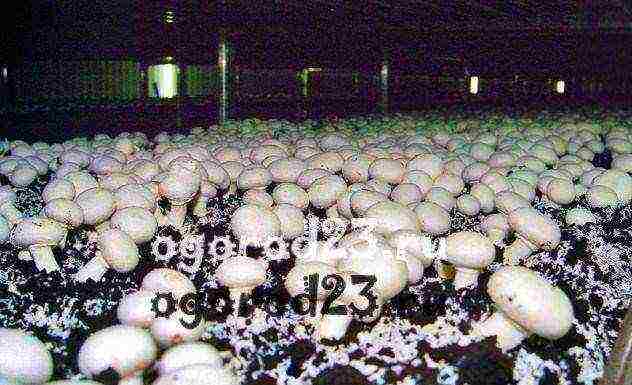
Before starting to practice mushroom growing, you should sensibly assess your desires and capabilities. In addition to time and money (purchase of materials), you must have appropriate premises.Some skills, a detailed study of information on the relevant Internet forums, the presence of a competent advisor will never hurt you. If we compare the process of growing mushrooms and oyster mushrooms, then our case, of course, is more time consuming. But if you compare it with the worries and nuances of growing porcini mushrooms, then it will be much easier, shorter in terms.
↑ back to content ↑ Where do mushrooms grow in nature?
If we consider natural conditions, then they are found almost everywhere. Forests, steppes, meadows, forest edges, lowlands, open spaces with moist soil and even semi-deserts, mountain forests are common habitats.
As for the "home" conditions, they can grow in a garden or vegetable garden, cellar, basement, specially equipped garage, greenhouse.
How to grow mushrooms? Many years of experience of mushroom pickers have proven that they grow best where the basement is equipped with good ventilation.
In this case, the air temperature should be relatively cool (not higher than +20 ° C), and if this process is set to flow, then the indicator of the mercury column on the thermometer should vary between +12 .. + 18 ° C all year round. The percentage of humidity should be approximately 70..85%, lighting does not play a special role.
It is not recommended to cultivate mushrooms in an apartment due to the lack of all the required standards: temperature, the presence of compost (odors from it), lack of space.
↑ to content ↑ Cultivation of champignons at home - technology
The necessary factors for a successful process are:
- The right choice of location.
- Disinfection of the premises.
- Microclimate organization.
- Competent preparation of the substrate.
- Composting.
- Mycelium selection.
- Planting mycelium.
- Appropriate care.
As mentioned above, under properly organized conditions, mushrooms can be grown throughout the year. The technology itself is not very complex, as it might initially seem. From the very beginning, you need to correctly arrange everything, and then the process will go along the knurled path. This work can even be called creative, something like a hobby. To date, breeders have bred approximately 50 varieties of this mushroom, which have minor differences in appearance. The color of the cap, its structure, and the duration of storage may vary, but all cultivated varieties are “children” of the common white champignon.
An example of a light brown variety in the photo:

Let's consider basement growing as a basic example, since this method is considered the most common. For so-called “cellar” breeding, it is best to choose high-yielding varieties such as Sylvan 130, Hauser A15 or Somycel 512. They are quite unpretentious, it is not difficult to take care of them, and they are also very "prolific".
Remember - the most important factor for the successful result of your efforts is the presence of well-established ventilation in the room where the mushrooms will grow!
A constant supply of fresh air is very important, since during growth they emit carbon dioxide, and its excessive concentration in the room leads to stretching, lengthening of the mushroom leg.
↑ back to content ↑ Growing mushrooms in the basement
The selected room must be decontaminated. This factor does not depend on whether it is a basement, a garage or a separate shed. As mentioned above, in addition to high-quality ventilation, there must be a high level of humidity. This is necessary for the qualitative growth of mushrooms, but high humidity is a direct path to the appearance of mold and various fungi on the walls and shelves. In addition, the champignons themselves are extremely sensitive to all kinds of parasites and diseases. Therefore, the processing of the premises is a must for the mushroom grower.
How to grow champignons at home - disinfection of the premises:
- Of the most common, often used, it is whitewashing of the ceiling, walls, all surfaces with limestone with copper sulfate (copper sulfate) added to it. The so-called "recipe": 2 or 3 kg of slaked lime + 100 g of copper sulfate per bucket of water (10 liters). When working with disinfectants, be sure to wear a face shield!
- The second method is more dangerous for the human respiratory tract and also requires protection. 350 g of bleach is taken, diluted with 10 liters of water, applied by irrigating the walls of the room.
- Irrigation of walls and other surfaces with 4% formalin, using a construction spray gun is the most convenient.
- You can fumigate a room with a sulfuric checker - it also gives a very effective preventive effect.
- Chlorophos is a radical, destructive method, but too poisonous in its composition. It works not only on mold, but also on harmful insects.
After any treatment, the room must be properly ventilated - this is also a prerequisite.
Let's go back to ventilation, or rather - let's clarify one nuance: the air should be fresh, but drafts should be excluded. It is better to close ventilation pipes ("strangleholds") with nets with a fine mesh - this will create an obstacle to the penetration of insects, as well as a small barrier for air masses. If you have a serious room of large size, and the cultivation is on stream, then the ventilation system should be more global, with additional fans located above each large box. If opportunities allow, then the installation of air purifiers with replaceable filters will not be superfluous for this business.
It is clear that a thermometer with a hygrometer is essential for a room where mushrooms are grown. So you can always control the level of air humidity: if there is a lack, sprinkle with water from a spray bottle, if there is an excess, ventilate. With the onset of the summer heat, the fans solve this problem, but if the cultivation of this type of mushroom takes place throughout the year, then in addition to all the aforementioned benefits of civilization, you will also need additional heating of the basement or cellar.
Large cellar room, photo:

It is best if your cellar, in addition to all the requirements for growing, will have an earthen floor (not concrete). By and large, the more purposeful the room will be adapted specifically for mushroom growing, the better. Any unnecessary additional factors in the basement, cellar, garage or shed that are not related to the cultivation of mushrooms will only interfere and disrupt the "microclimate" of the room.
To the "pluses" of mushroom science can be added the fact that they are able to perfectly bear fruit even in complete darkness. This sets them apart from all other green dwellers. The weakest light bulb is enough - they will feel comfortable, but the light, rather, will be more useful to you in order to comfortably navigate in the place.
If growing champignons at home initially has far-reaching plans, the owner has a large room, then dividing it into 2 zones will be a reasonable, convenient solution. Simply put - mushrooms must emerge somewhere, and a specially prepared substrate is designed for this process (more on that later). So, in one zone there will be a substrate through which the mycelium will spread (this is called incubation). In the second compartment, boxes with mushrooms will be placed directly, where they will be distilled.
The temperature regime of these two compartments should also be different: mycelium usually grows at a temperature of +23 .. + 24 ° C, and the growth of mushrooms occurs at a temperature column of +16 .. + 18 ° C. If you get used to it, work out your own "schedule" of moving boxes from one zone to another, you will be able to grow these delicious, beloved mushrooms all year round.
↑ to content ↑ Compost for growing mushrooms
Composting (substrate) preparation is one of the most critical aspects of mushroom growing. The quality of the mushrooms will directly depend on a properly prepared substrate. Usually, when you buy mushroom mycelium, the packaging with the contents indicates the appropriate substrate for this variety, as well as the nuances of its preparation. The varieties are different, and the composition of the compost, its collection technology may vary. However, most often these parameters do not differ significantly.
Mycelium, photo:
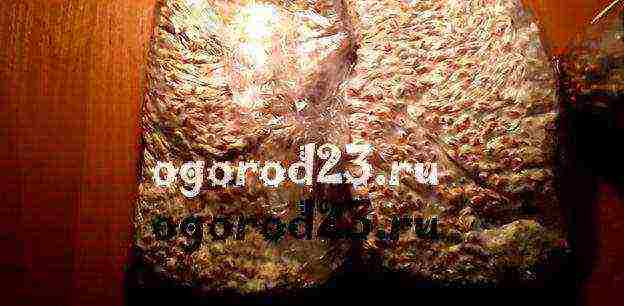
The substrate should be prepared either in a specially designated room for this purpose, or in the open air (outdoors), under a well-equipped canopy. It is important that no precipitation (rain) or sun rays fall on the compost. It is also highly discouraged to pour compost on the “bare” ground - spread a sheet of thick plastic wrap. Thus, unwanted insects or any other pests will not penetrate into the substrate. It should not touch the ground, but blowing air over it from all sides is a must!
The mushroom compost should be moderately moist, as excess moisture can disrupt proper fermentation processes.
Be that as it may, the street is the best place for the maturation of the substrate, the active release of ammonia, carbon dioxide will not be useful to anyone. The average time of "readiness" of the substrate, its fermentation, is approximately 25-30 days. During this period, it is recommended to stir it at least three times (to ensure even fermentation). You will know that the process has come to an end by the absence of a specific smell of ammonia. By this time, its color acquires a brownish tint. While the substrate is fermenting, the temperature inside it can be about +50 .. + 65 C °, and the compost already ready for use has a temperature of no more than +24 .. + 25 C °.
By the way, to enrich the contents of the compost when you first stir it, you can add crushed lime to the total composition. During the second mixing - superphosphate fertilizer, during the third - ground gypsum or its construction analogue (alabaster). Already "ready" substrate, in addition to the above-described features, does not stick to hands, springy with tactile contact, the straw is extremely softened, easily divided into fragments.
As an alternative to the independent process of compiling the substrate, you can advise the purchase of ready-made compost, which is sold in garden departments of supermarkets or flower shops. Of course, such a substrate will be of lower quality than one prepared with one's own hand, although it will be written on the package that it has all the required characteristics.
It is up to you to decide what is more convenient for you, whether you have the time to carry out all the points of preparation for growing these mushrooms. While looking at the common attributes of good compost, let's highlight the main ingredients.
The composition of the compost for growing mushrooms:
- For these purposes, it is considered to be the best horse waste products. In addition, it is important to consider that the horses ate hay, and not green grass. The moisture content of horse manure for composing the substrate should be approximately 45%. Horse waste can be replaced with cow or bird waste, but, according to the experience of experienced mushroom pickers, the harvest on such a "basis" will be much worse. So, you need about 100 kg of horse manure.
- Straw - choose a dry, rye or wheat variety. You will also need about 100 kg of it.
- Alabaster (gypsum) - about 6 kg.
- In other cases, alabaster is replaced with urea (2.5-3 kg) or the same amount of nitrate (per 100 kg of straw and 1000 kg of manure). As we remember, these fertilizer additives are applied while mixing the compost.
- Again, using 100 kg of horse waste, 100 kg of well-dried rye straw, 3 kg of urea, 5 kg of chalk, 2 kg of superphosphate, 8.5 kg of gypsum, when mixed, will create an optimal ratio of ingredients.
How to grow mushrooms at home? Use fresh animal waste while still providing maximum nutrient content. Make sure that there are no coniferous shavings or sawdust in the introduced components - they release resin, and these mushrooms feel it, react painfully to its presence. Phosphate fertilizers, as well as urea, are actually highly recommended, useful - they are sources of phosphorus and nitrogen, which are so necessary for mushrooms. But chalk normalizes the acidity of the substrate, maintains the optimal pH level.
Champignons: growing at home - the easiest way to create layers:
- We take a convenient wide container, fill it with hot water, soak the straw for about 24 hours.
- After that, we lay it in layers together with manure. You will have about 5-6 layers. Do not forget to moisten each layer with not very hot water, lightly, but do not moisten abundantly.
- After 3 days have passed, we take a pitchfork and thoroughly mix the compost-straw "cake", but at the same time we add fertilizers - superphosphate with urea (urea). At this stage, the substrate begins to smell strongly of ammonia. After 4 days, we shovel the substrate again, additionally adding those dressings that are required by the standard for this variety.
- In general, the mixing of the compost should be done about 4 or 5 times at a time. Do not spare any effort on this - useful elements will be evenly distributed throughout the entire composition, and the mass will acquire a relatively uniform consistency.
The so-called "care" of compost has already been described above, but I would like to add, repeat about the warning about excessive moisture. Too much moisture in the substrate will slow down its maturation, but even worse, it will wash out all the useful ingredients required for development and growth from the mixture.
Compost components (dry hay, horse manure, fertilizers), photo:
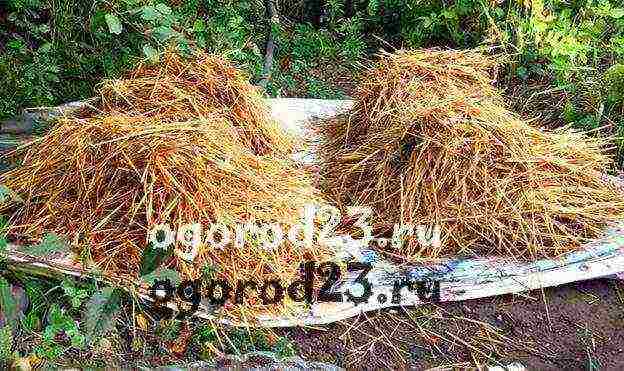

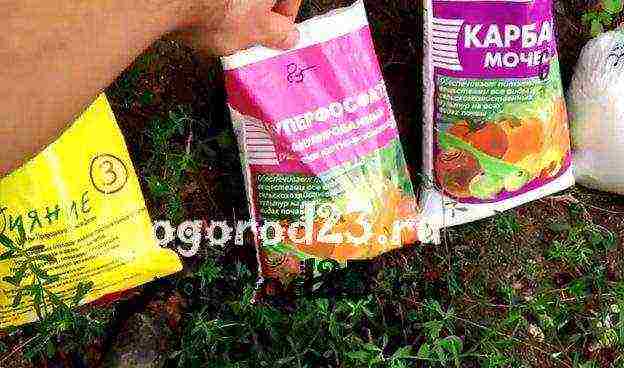
↑ back to content ↑ Champignon mycelium - planting
The substrate, of course, should be purchased from a reliable representative (best of all - special laboratories). When the compost is already ripe, we transfer it to the appointed place, lay it out in boxes or special forms, where further actions will take place:
- To get a good harvest of mushrooms, about 500 g of mycelium or 400 g of these varietal spores are needed per 1 m² of compost.
- If mycelium is used, then small dimples, 4 or 5 cm deep, should be made over the entire surface of the container with compost, at a distance of 20 cm from each other. An appropriate amount of mycelium is laid in these pits, but if fungal spores are used for sowing, then they are simply scattered evenly over the surface of the substrate.
- After a while, you will notice cobweb strings covering the surface of the compost containers. By this time, the temperature of the humidity in the room should be at the level of 75-95%. To prevent the substrate from drying out, it can be sprinkled from time to time with clean, settled water from a spray bottle, and additionally covered with a clean damp cloth or paper.
- The mushroom mushroom begins to grow at a temperature of +20 .. + 28 C °, the active phase of the spread of the mushroom "spider web" occurs after about 10 or 12 days, then the top layer of compost will need to be sprinkled with the appropriate soil mixture (about 4-5 cm), wait another 3 days, after which move the containers with future mushrooms to a colder room with a temperature of +12 .. + 16 ° C. Or, forcibly lower the temperature in the room to a given indicator of the mercury column.
- Please note that ordinary garden soil for "sprinkling" will not work for you.Prepare in advance a mixture of 1 part limestone, 5 parts peat, 4 parts clean soil. After 3 - 3.5 months, expect the first well-deserved results of your labors.
A harvest from one mycelium can give from 5 to 8 ripening periods for new mushrooms. This is called a "wave", the most generous collection of mushrooms falls on the first three "waves". Here it is important to catch the moment of ripening - when the cap is still tightened from below with a thin white skin (film), and brown plates are not yet visible. Mushrooms need to be twisted, as it were, from the place of their growth, but not cut off (so that harmful bacteria do not penetrate into the mycelium through the cut site).
After the crop is harvested, gently sprinkle the substrate with the above-described soil mixture again. During the next two weeks, they will grow especially actively.
A mushroom correctly extracted from the soil, photo:

Hat in optimal ripening state, photo:
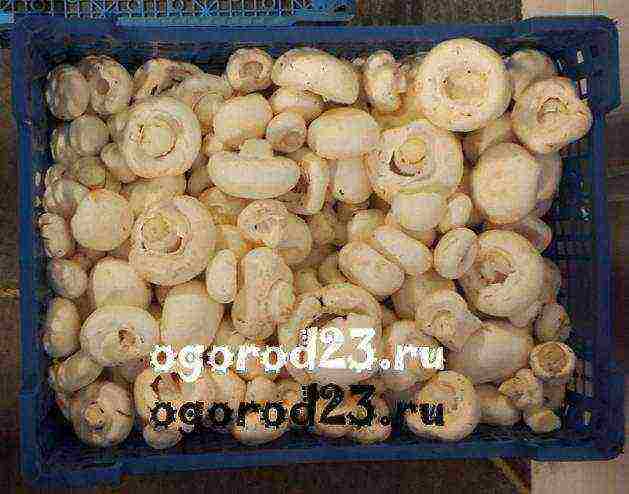
↑ to the content ↑ How to grow mushrooms in the country in the open field?
In addition to the most commonly used "basement" method of growing mushrooms described above, there are other alternatives. For example, how to grow mushrooms at home, namely, at their summer cottage. Sometimes, for some reason (lack of a basement, garage or other suitable premises), the desire to grow these mushrooms seems impossible. But if you are the happy owner of a summer cottage, everything is feasible!
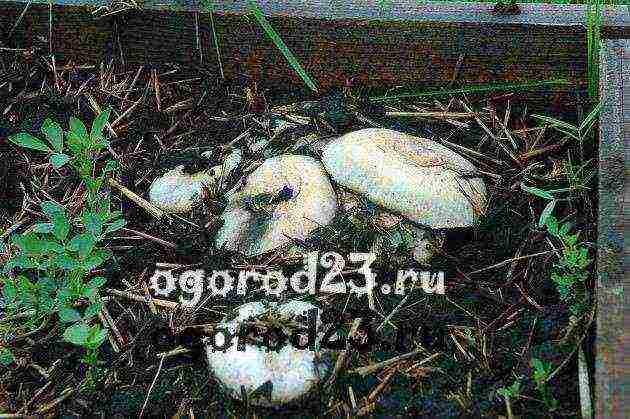
The most successful period for this is summer and autumn, here it is also important to choose a comfortable place. Champignons - where do they grow? In shaded places, on specially prepared soil, the place for the mycelium should be moderately moist, the earth should not dry out, the sun's rays should not illuminate the chosen place too much. To protect against drought on hot days, the beds are often covered with plastic wrap or special covering material to create a certain microclimate. It is important to bring mushrooms as close as possible to conditions similar to their natural growth environment. Since we cannot influence the weather conditions, we must try to give the mushrooms moisture - when they need it, as well as the availability of fresh air.
In the garden under the trees, photo:
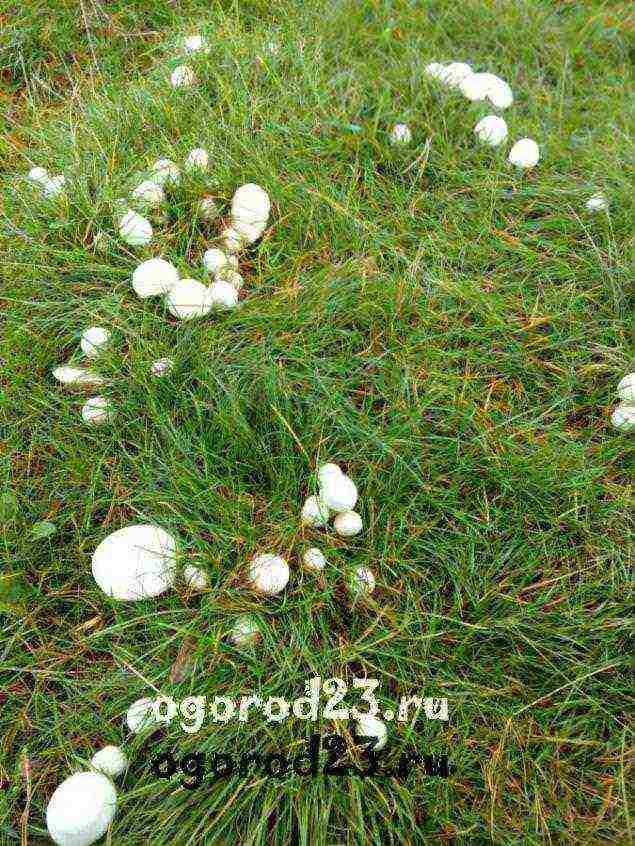
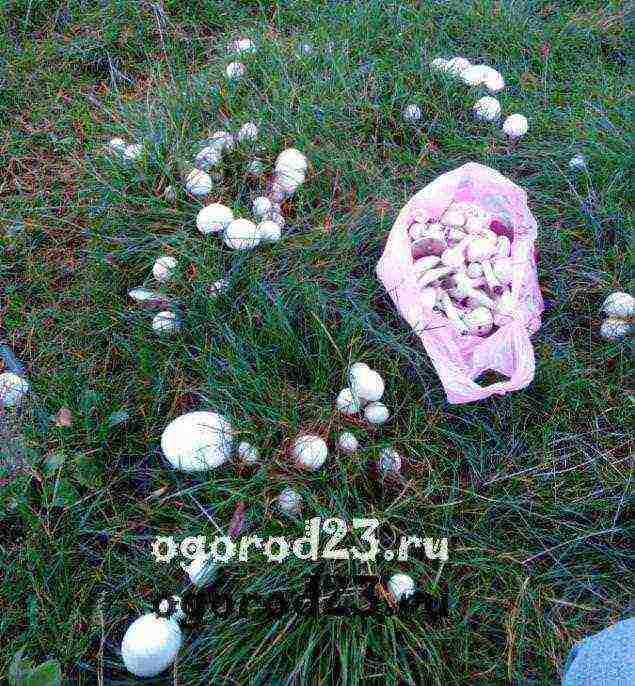
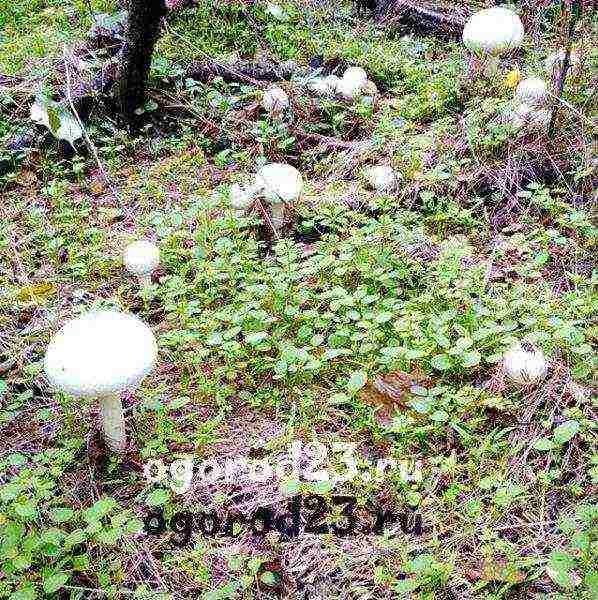
After sowing the mycelium in the beds, in the open field, growing champignons - their technology, practically does not differ from the rules for growing in a cellar. After a couple of weeks, the "cobwebs" of mycelium grow over the soil surface, at this point the temperature is lowered by sprinkling the soil surface with a thin (up to 5 cm) layer of moist earth. The temperature, similarly, should vary within +12 .. + 15 С °, but in no case should it reach above +20 С °. As in the above method, it will be much more productive if this land contains peat and limestone. Regular watering (or rather, delicate irrigation) is best done after sunset - this will optimally moisturize the soil and prevent a dense earth crust from forming. With the right approach to business, in about 3-4 weeks you can expect a harvest of your own mushrooms.
Mycelium sprouts cobwebs, photo:
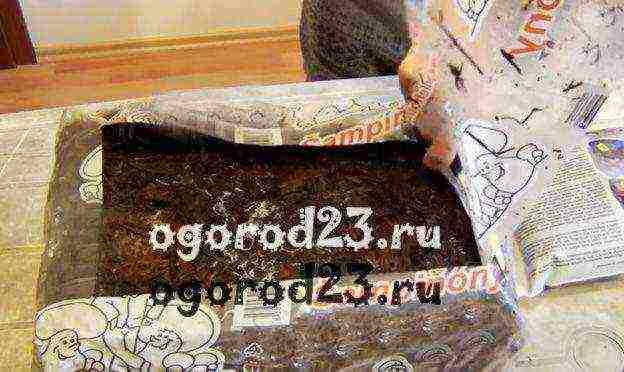
Let's summarize how to grow mushrooms in the country:
- It is better to plant mycelium or spores on specially prepared soil. This can be soil brought from the forest zone.
- The soil should be optimally saturated with fertilizing, be well moistened, not have stones, brick fragments or remnants of old roots.
- It is best to plant mushrooms outdoors at a neutral air temperature - +21 .. + 22 C °.
- If a greenhouse is chosen for planting, you should carefully monitor the level of humidity and air temperature in it. The conditions are not very different from the basement or garage cultivation of mushrooms. It should be remembered that heat and drought are destructive for them.
- As already mentioned, the planting technique does not differ from the "basement" analogue (20 cm from each other, shallow pits, dusting with earth mixture after the appearance of the "cobweb").
- With the receipt of the first mushrooms, the abundance of watering can be reduced (so that the roots do not rot), irrigation is our everything in this matter.
After all the waves of the mushroom harvest come to naught, the spent substrate can be simply disposed of, or it can be quite successfully used as an organic fertilizer or mulch for some trees or even flower beds. Of course, it is no longer suitable for re-growing mushrooms, but as an excellent top dressing for your green inhabitants, it will quite serve. As for all kinds of containers, boxes after harvesting and composting, they will require mandatory disinfecting treatment, as well as the room where the mushrooms were grown.
↑ back to content ↑ Reviews of those who grew champignons
Champignon is such a mushroom, the demand for which is much higher than for oyster mushroom. For example, we buy them for every holiday, but oyster mushrooms, perhaps once or twice a year. If oyster mushroom can be grown in the garage without any preparation, then, for the champignon, you need to specially equip the room with ventilation, irrigation, and an automatic system for maintaining the set temperature.
Goshek
A friend of mine grew mushrooms in the basement of a wooden house. As a result, the logs were infected with a fungus. It is better to grow them in a specially designed room.
Nadeya
Hi, I don't know if my experience will come in handy, I really just collect them, I work on the farm where they are grown. 1) they do not need light at all. They grow in our dark hangars. When we work, we turn on the light, of course. When not, then no. 2) When they germinate, you do not need to water them. It is necessary to water before such small fungi come out, otherwise if water gets on them, they get dirty and get sick 3). We have sawdust (more precisely, compost with straw) in a layer of about 15 cm, and sprinkled with earth on top. The ground layer is about 5 cm. The total height of the beds, respectively, is 15 + 5 cm. 4) Temperature + 15-20, the lower (up to 15), the supposedly better they grow. 5) I don’t know about humidity, I haven’t seen the sensors even once, but it’s quite possible - since we have them in 5 rows (racks) 6) Harvesting: Tear off carefully, as if unscrewing it from the ground, it is enough to make half a turn. Collect gradually as it grows. As soon as the caps begin to open (they become such a brownish color and soft to the touch, but have not yet opened), collect everything that has come out with the exception of the smallest ones the size of a fingernail. Water again, as it should, and wait a week for the second harvest. Then we can wait for the third. We have the third - the last one, then everything is thrown away (composted) and everything is laid again anew.
Nadya
Yes, they grow on their own 😉 We put cow dung in a pile, and the cows graze in the meadow, where mushrooms and hats are found and eat. Here we grew up on last year's manure, and when they sprinkled the garden with manure, they grew there for 3 years, not much, but there was enough for pizza.
Gopher
Growing champignons at home for beginners cannot be called an entirely easy process, but, as in any new business, observing the rules, as well as taking into account the advice from already experienced mushroom pickers, will undoubtedly help you in this interesting, exciting activity. And the crop grown with your own hands will delight you, your loved ones and, quite possibly, will bring material income!
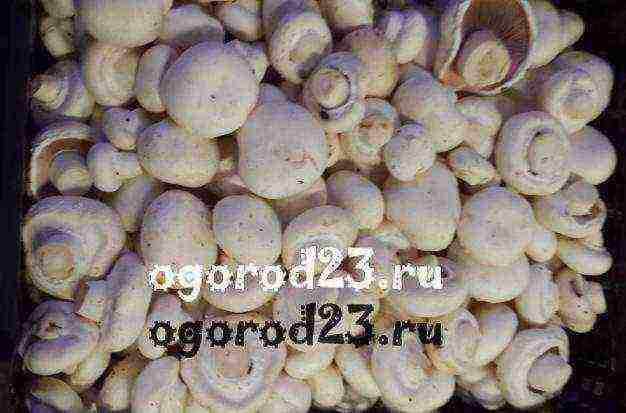
As soon as you get a taste of growing mushrooms at home, the question of how to grow mycelium with your own hands will become acute. The most convenient and simple method is to grow mycelium on cardboard.
Why is cardboard a good material for mycelium growth?
- First of all, other forms of life are reluctant to develop on cardboard.
- Cardboard is made of wood (cellulose), so this material is familiar to mycelium, originally grown on sawdust and wood chips. Colonization will take place quickly and efficiently.
- Corrugated cardboard allows the mycelium to breathe. In the case of sawdust, the mycelium often lacks air and colonization stops due to the compaction of the material and poor air exchange.
- Cardboard holds moisture well.
- It doesn't need to be sterilized. Just make sure all materials are clean and the cardboard is free of stains and odors. You don't have to worry too much about sterility.
- A lot of mycelium can be grown on cardboard with minimal investment of time and effort.
- Cardboard is available anytime, anywhere.

One of the options for growing mycelium. The car of this master class disinfects pieces of mushrooms in hydrogen peroxide.
How to grow mushroom stem mycelium on cardboard
Choose corrugated brown cardboard without writing or paint. If there is glue on it, remove these places.
Materials:
- Plastic containers (size depending on the amount of cardboard and needs)
- Mushroom waste (legs, trunk, bases)
- Cardboard can be torn at will, or cut... Soak the pieces of cardboard in boiled warm water in a clean dish for an hour. If the cardboard is in the water longer, nothing will happen to it.
- Prepare seed... Basically, you can grow mycelium from any mushroom, so I encourage you to experiment. You need to "unscrew" the stem of the mushroom from the substrate, as deep as possible (if you are growing from your own mushrooms).
- Divide the stem of the mushroom into fibers... This can be done by hand or with a clean knife or blade.
- You need to punch holes in the container for drainageso that standing water does not provoke mold.
- Drain the water carefully from the cardboard... Carefully peel off the top layer of paper from the corrugation, place the mushroom pieces on the corrugated part of the cardboard at a short distance. Cover with previously removed paper.
- Place the pieces of cardboard with the seed in the prepared container.... Press down lightly on the cardboard layers to ensure that the mushroom contacts the cardboard without air pockets.
- Cover the container with a bag to protect it from drying out., but you need to ventilate daily.
- Moisten the cardboard from the spray bottleI, when it seems to you that it has dried up.
- Take off the package dailyso that the carbon dioxide is replaced by fresh air.
- The container should be in a dark, warm place.... The cardboard should be completely white in a period of 3 weeks to 2 months. Below I have selected a couple of videos with good workshops on growing mycelium on cardboard.
How to use mycelium on cardboard for growing mushrooms?
The cardboard is completely white. What to do with cardboard:
- If you leave it alone and keep watering, it will sprout. But too much mycelium and too little nutrition for a rich harvest will not yield. It is possible to grow on cardboard, and this is not the worst way.
- Cardboard mycelium can colonize mushroom "beds" of sawdust, straw, compost and wood chips in the open air.
Colonize bales of pasteurized straw with cardboard mycelium. A good option for growing on the balcony. - You can use cardboard mycelium for any type of substrate - paper, coffee grounds, tea leaves, recyclable materials and even fabric.
- Colonized pieces of cardboard will easily populate a new portion of mycelium. Do the same with the cardboard and transfer it with pieces of cardboard mycelium - the cycle will start again, but much faster. After all, mushrooms remember the environment of their previous colony and transmit information in their genome to the next generation of mycelium.
- Cardboard mycelium, like any other, must be used as quickly as possible. You can do this: use part of the mycelium to colonize the substrate, part to produce a new portion of mycelium.
- Cardboard can be colonized with any source of mycelium - mushroom sticks, mycelium on sawdust, straw, grain. I'm pretty sure that even the mythological "dry" mycelium from bags can miraculously wake up and populate the cardboard.
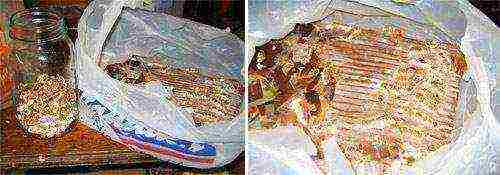
Mycelium on cardboard made of mushroom sticks.
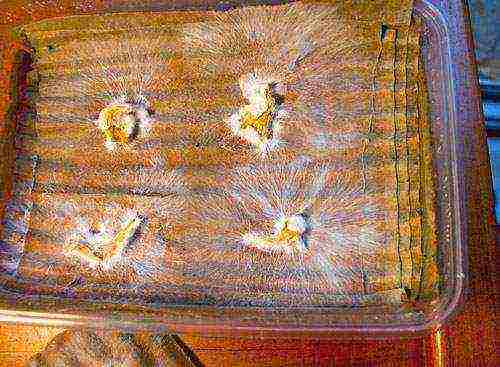
In the process of colonization.

